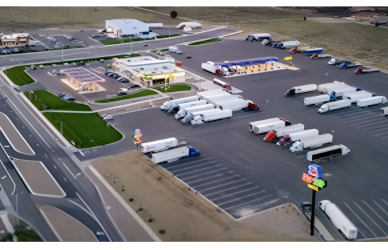Have you ever gazed at the mammoth trucks thundering down the highway, the sun glinting off their polished chrome, and wondered what it’s like to be in the driver’s seat? The allure of traversing the country from coast to coast, witnessing the diverse beauty of landscapes, is a dream that’s always on your mind. You’ve got the spirit of a truck driver within you, but you might be wondering, “Where do I even begin?”
In today’s world, with an abundance of career opportunities and specializations in every field, truck driving is an excellent option for those who feel the call of the road. This dynamic industry has adapted to the ever-changing economic landscape, offering a wide array of options. Whether you aspire to transport commercial goods, specialize in moving stage setups for live performances, or operate a mining truck for a lithium mine powering electric cars of the future, the trucking world is ready for you.
Obtaining a commercial driver’s license (CDL) can be the key to unlocking a world brimming with opportunities, job satisfaction, and substantial earning potential; however, the days of simply hopping into a truck and hitting the open road are mostly behind us. Nowadays, formalized educational courses coupled with hands-on experience are the norm to prepare you for the road ahead.
CDL Requirements
The CDL requirements differ significantly from those of a standard driver’s license, particularly concerning the type of vehicle you can operate and the age at which you can obtain a CDL. While specific details, such as timelines and fees, vary by state, some general guidelines apply. Typically, candidates must be at least 18 years old to drive within their state, but after turning 21, CDL holders can cross state lines and explore broader opportunities.
Truck drivers must also pass a Department of Transportation (DOT) medical examination conducted by a qualified physician. This rigorous examination is necessary because the trucking industry demands drivers to navigate multi-ton vehicles through challenging traffic conditions across the country. The profession requires both physical and mental fitness, with drivers needing to perform at their best mentally and maintain a level of physical acuity. Medical conditions that could lead to a loss of consciousness, hearing, or vision, as well as compromised nervous systems or physical limitations that might interfere with driving ability, can disqualify a candidate. Certain heart conditions, epilepsy, inner ear diseases, diabetes, high blood pressure, and respiratory issues may also be considered disqualifying factors. In some cases, however, these restrictions can be mitigated with a physician’s plan to ensure maximum safety.
Where to Get Your CDL
As you embark on your journey to earn your CDL, choosing the right training is crucial. Truck driving schools are the primary entry point for aspiring truckers, but they are not the sole option. Let’s explore various paths available to prospective students, considering the advantages and drawbacks of each.
- Private CDL Schools
Private CDL schools are the most popular training route for new drivers. These schools offer flexible training durations, with courses ranging from a few weeks to a full year and costs varying between $1,000 and $10,000. Private CDL schools provide students with personalized attention and individualized driving instruction. Their comprehensive courses cover a wide range of topics, including pre-trip inspections, trip planning, coupling procedures, logbooks, air brakes, loading and unloading, load security, and more – all essential knowledge for a truck driver.
While the courses at private CDL schools take some time to complete, many of them offer weekend options to cater to students with full-time jobs. These schools are often conveniently located, and they provide flexible payment options, financing, and access to federal funding for students seeking financial aid.
- Community Colleges/Trade Schools
An alternative approach to truck driving education can be pursued through community colleges and trade schools. These institutions offer a more traditional learning environment and are suitable for those who prefer a post-secondary education setting.
In certain states like Delaware, Indiana, Louisiana, Mississippi, Missouri, Oklahoma, and Tennessee, the College Promise program can cover the cost of tuition, making it an attractive financial option for students. Some colleges and trade schools even offer one-year degrees related to the commercial freight business, providing students with a deeper understanding of the industry and potential for diverse opportunities in the future.
The downside of these programs is their duration, with students typically required to commit to 6-9 months of training, delaying the start of their truck driving careers.
- Paid Training/Company-Sponsored Training
Many large carriers offer in-house training programs, hiring prospective drivers and immediately sending them on the road with experienced trainers. The training provided by these programs ensures that you’ll be well-prepared for the world of truck driving. One significant advantage is that you’re guaranteed a job upon completing the training; however, during the training period, your pay might be lower. Companies typically require trainees to commit to working for them for a year after training, with lower wages during that time. If you choose to leave the company, you may be required to repay the training costs.
The benefits of employer-sponsored training programs include guaranteed employment, training on company equipment, and free training. Nevertheless, you should be prepared for extended periods away from home, a one-year commitment, and lower wages during the training period.
- Self-Training
While some individuals may attempt self-training, this approach is becoming increasingly impractical due to the growing requirement for mandatory entry-level training. Furthermore, many insurance companies now prohibit carriers from hiring new CDL holders who haven’t completed a minimum of 160 hours of training and instruction. Self-training might be cost-effective, but it’s unlikely to lead to employment with a reputable trucking company. Thus, it’s generally not worth your time to pursue a CDL through self-training.
Obtaining Your CDL
No matter which training path you choose, your journey begins with a CDL study handbook. Each state provides its own handbook reflecting state-specific details, so be sure to obtain the relevant one. These handbooks are comprehensive guides to understanding the rules of the road and the intricacies of truck driver training, and they are typically available at your local DMV or online.
To start the process, you need to secure a commercial learner’s permit (CLP) before enrolling in any training program. The CLP test comprises three categories: general knowledge, air brakes, and combination vehicles. You must correctly answer at least 80% of the questions to obtain your CLP.
In addition to studying for your permit, you must meet specific requirements, which include being at least 18 years old (or 21 for interstate driving), possessing a non-commercial driver’s license, providing proof of citizenship or lawful residency, and demonstrating effective English communication skills.
Besides these requirements, there is an application fee for your CLP, which varies from state to state, and you can expect to spend around $100, along with the cost of a DOT driver’s medical exam.
With your CLP in hand, you can embark on your CDL training journey. Be aware that there are additional fees associated with the process, such as the commercial driver’s license application fee (up to $45), CDL written test fees (up to $125), CDL skills test fees (up to $125), and various endorsement fees for specific vehicle types (e.g., bus, tanker, hazardous materials).
Testing
After studying, financing your training, and completing your requirements, it’s time to face the tests. Here’s a quick overview of the testing requirements.
- General Knowledge Test: This multiple-choice exam is mandatory, and you must achieve a score higher than 80% within a 60-minute time limit. It covers various topics, including pre-trip inspections, communication, the dangers of driving under the influence of drugs and alcohol, and general trucking knowledge.
- CDL Road Test: This comprehensive examination assesses your ability to operate a truck, covering pre-trip inspections, coupling procedures, on-road operations, and backing into loading docks. You must demonstrate care and control of your vehicle throughout the test.
Typically, you have three opportunities to pass the tests, though this may vary slightly from state to state. Additional fees may apply, with each test potentially costing over $100.
Success as a Driver
Once you’ve successfully passed the tests and obtained your Commercial Driver’s License, you may find yourself asking what steps you should take next.
It’s time to enter the job market. There are over 500,000 trucking companies across the nation, offering a wide range of opportunities. While some companies might not accept new drivers due to insurance policies, many others will. Don’t be disheartened if you face initial rejections; it’s not a personal judgment.
As a new driver, expect to start at the entry level, just as you would in any other industry. You might not get the newest truck or the best routes immediately. Allow yourself time to become familiar with the company, its expectations, and the equipment. As you prove your competence, you can look forward to working with newer equipment, better routes, and increased pay.
For new drivers, it’s essential to give yourself at least a year to adjust to the unique working environment of truck driving. This dynamic career empowers you to contribute to the nation’s economy by moving vital goods that keep various businesses, from big box stores to hospitals, schools, and factories, running smoothly. As you park your truck at the end of the day, you can rest in your sleeper knowing that you’ve played a vital role in serving others and keeping America’s economy going.











